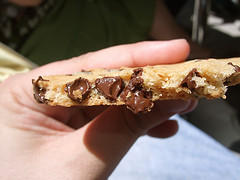You've probably all heard about the five-second rule at some point in your life. This "rule" states that if you drop a piece of food on the floor and pick it up in under five seconds, the food is still safe to eat. Many of us might even be living by this rule, but does the five-second rule have any basis in science? In short, no!
The origins of the five-second rule are unknown, but science has proven that the rule simply doesn't hold water. In 2003, Jillian Clarke, a high school senior, performed an experiment at the University of Illinois during a school internship. Her experiment proved that E. coli bacteria can transfer to food well under the five-second mark. Researchers at Clemson University took this experiment a step further in 2007. The scientists applied a large amount of salmonella to various types of surfaces to see how long the bacteria could survive. After three weeks, a good amount of salmonella was still living on the surfaces. The longer food was left on these surfaces, the more germs the food acquired. In just five seconds, the number of germs measured on a piece of food was between 150 and 8,000.
So, the next time you drop that beloved cookie on the floor, just throw it out and go buy yourself a new box of cookies. You never know what could have attached itself to your treat!
The Five-Second Rule [Kids Health]
5 Second Rule With Food On Floor [MythBusters]
Fact or Fiction?: The 5-Second Rule for Dropped Food [Scientific American]


 Equal Housing Opportunity
Equal Housing Opportunity